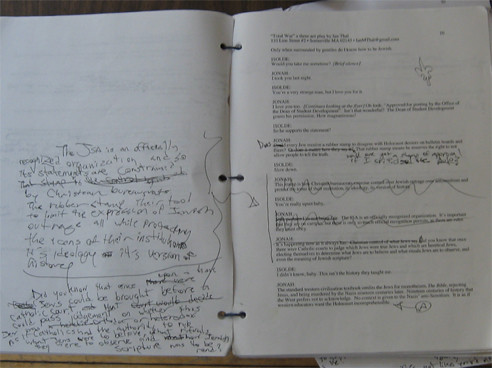
Given the downtime following my stint teaching with Open Air Circus, and the need to spend a lot of my time waiting around the apartment as I interview potential roommates, I have been sitting on the living room sofa revising the script of my play. In order to avoid the phenomenon of having a story whose beginning is well crafted but makes little sense by the end, I decided that this stage of revision will involve working page-by-page starting with the last page, working my way to the front, as I work on tightening the dialogue. Given the fact that English runs left to right, and Hebrew runs right to left, I have been referring to this as the "Jewish revision."
The next phase of the revision process will be an "English phase", working from first page to last, and will involve improving on the structure of the narrative, mostly expanding on the role of some of the supporting characters.
Working on a play on the topic of Holocaust denial, further underlines to me that my break with Bread and Puppet Theater was inevitable after Peter Schumann's "Independence Paintings: Inspired by Four Stories" trod dangerously close to Holocaust denial, and noticeably inflamed anti-Semitic sentiment. Despite that, there is one scene in the play that displays the storytelling techniques I learned during my time with Bread and Puppet. I celebrate complexity-- this is perhaps why I try to weave so many themes into a single blog: the aim is to integrate and synthesize, not compartmentalize.
On the issue of complexity: I have discovered that even as I aim to craft such a darkly themed piece, the influence of commedia dell'arte is present as well.
Thursday, August 30, 2007
Revising Backwards
Posted by
Ian Thal
at
9:54 AM
3
comments
![]()
![]()
Labels: Antisemitism, Bread and Puppet, commedia dell'arte, Holocaust Denial, Peter Schumann, theatre, total war, writing
Saturday, August 25, 2007
Can You Identify These Puppets?
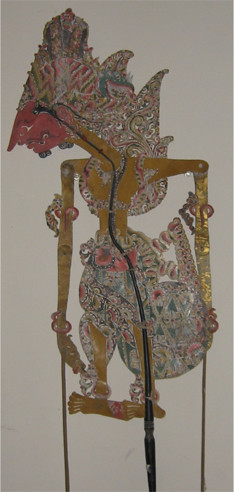
Earlier this summer, I chanced upon a garage sale only a block from home and found these two shadow puppets. After inquiring as to their price I was given an offer I could not refuse. They are part of the tradition of Wayang Kulit, the shadow puppet theatre of Indonesia. I had first seen puppets of this nature at the Smithsonian's Arthur G. Sackler Gallery of Asian Art in Washington, D.C., likely when I was on break from college. While the soon-to-be former owner was able to tell me that these puppets were of Javanese origin (as opposed to the Balinese puppets I had seen at the Sackler) he could only identify them as figures from the heroic epic, the Mahãbhãrata.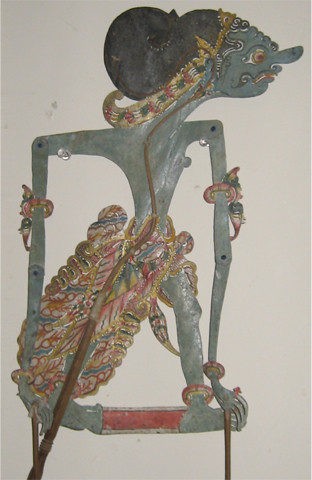
So, dear reader, can you help me identify them? It is clear that the red faced fellow is a prince or noble of some sort, and that the blue fellow is of lower status, but is he a lower-ranked prince? A servant? Perhaps one of the comical figures of Wayong known as punokawan who, from their description, seem analogous to the zanni characters I often play when I perform commedia dell'arte?
Click here for the full photo set. My apologies as they are not my best photographs.
Posted by
Ian Thal
at
10:18 PM
7
comments
![]()
![]()
Labels: Mahãbhãrata, Puppetry, Shadow Puppets, The Smithsonian Institution, Wayang Kulit, zanni
Wednesday, August 22, 2007
Teaching Mime at Open Air Circus
In my previous post I described the commedia dell'arte class I taught this summer at Open Air Circus. In this one, I will describe the mime class. Though I do not have any photographs to share of this particular class, The Somerville Journal did post a slide show that include some photographs of my mime class in session as well as some narration that came from an interview I gave.
This was my third summer teaching mime at Open Air, and I've come to have many of the same children signing up for my class year after year.
Given the very short teaching schedule (cut short by a week due to peculiarities of the calendar and another week due to rain), I was left with very little opportunity to do more than teach the concept of isolations, Decroux' corporeal mime scale, and rhythmic dynamism and get a skit together for the final show
Isolations are an essential part of any mime technique, and even when taught systemically, they are difficult for many children to learn due to the fact that their nervous systems are just not fully developed, but into my third summer, I have a group of students who are very eager to please, and at a youth circus, being known as "the weird teacher" really isn't a problem.
The nice thing about any of the traditional repertoire of mime illusions is that they can all be used as lessons in technique, but even more so, they can be used as lessons in teamwork and working with your partner.
This year I decided to work on the rope-pulling illusion and revive "The Spaghetti Sketch" that I had created for the circus two years prior. The "Spaghetti Sketch" has two acts: The first being a tug-o-war competition, the second a spaghetti dinner between the two teams who are even more competitive at dinner than during the competition, where I play both referee and head waiter. The first night (given this year's theme of "Rock'n'Roll") we use Bill Haley's "Rock Around the Clock" for the spaghetti dinner. By the first matinée the music has changed to "Union Jack" by Big Audio Dynamite for the tug-o-war segment and an excerpt from "The Barber of Seville" for the dinner sequence. I have the kids develop their own individual spaghetti related lazzi while I improvise different bits of business each show. One that seems to work is substituting my top hat for a saucepan. The kids are particularlly excited that we've revived this piece as while a few had been in the first iteration from two years prior, many of them had seen it from the audience.
Peter Jehlen, the circus' artistic director, recruits me into incorporating my mimes students into the unicycling segment. He's chosen the music "Grease Lighting" from Grease and I borrow a couple of unicycles and build up some choreography based on various object manipulations (some of our experiments are seen in the slide show). Peter has another idea, which involves having four mimes playing air guitar to "Sergeant Pepper's Lonely Hearts Club Band" during the opening sequence of the show, so I end up spending the beginning of the show acting as a conductor-- showing my "guitarists" how to play strict 4/4.
(I discover during the finale of the last show of the weekend that as we play the "Sergeant Pepper's Lonely Heats Club Band (Reprise)" that the tatkar I have been learning in my kathak classes fits perfectly.)
Posted by
Ian Thal
at
7:41 AM
2
comments
![]()
![]()
Labels: Beatles, Big Audio Dynamite, Bill Haley, corporeal mime, Étienne Decroux, mime, Open Air Circus, Peter Jehlen, teaching, youth circus
Thursday, August 16, 2007
Teaching Commedia at the Open Air Circus
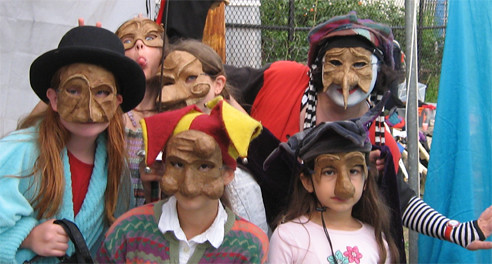
Click here for the full photo set
As I was preparing to teach another summer at Open Air Circus I thought back the past year's experience performing with i Sebastiani I lobbied to teach a class in commedia dell'arte as well as mime.
This quickly led to a problem, most of the children who gravitate to my classes have been girls, and traditionally, the masked characters of commedia have been male with actresses playing unmasked (and thus, less grotesque) female characters. I puzzled over how to give my girls the opportunity to play masks. I thought back to this past November when I saw Plunket & Tremolo, featuring Mark Jaster and Sabrina Mandell, perform commedia. In their show, Mandell took on a mask to play Smeraldina, a cook. portraying her as something of an older, craftier version of the Franchescina character we often use in i Sebastiani, I realized that there was nothing wrong with creating a mask for a female character if the mask was appropriate to the character. In addition, since we are all taught that the theatre of the English renaissance featured boy-actors playing women, there was no reason not to cast girl-actors as men. Once I solved those two problems, I was left only with the girls' willingness to play male masks.
So I began work on sculpting the masks from papier-mâché-- I was fortunate to discover that my skills had developed significantly since I last worked in that medium, and by the first day of class, I had masks for Arlecchino, Il Capitano, Il Dottore, and Pantalone. My class comprised of five girls and while I got a great deal of laughs from my depiction of Isabella as I introduced the characters, I decided, that owing to the age group, to dispense with the romance subplots. The girls all had an immediate sense of the vecchi, Dottore and Pantalone, and quickly came up with a lot of good verbal lazzi. The girls seemed to have a great deal of fun lampooning foolish men.
I went home and began work on a Franchescina mask-- reasoning that I wanted it to cover less of the face than most commedia masks and to have both the furrowed brow of a hard working zannia as well as some seemingly delicate features one would attribute to a young commedia heroine.
Over the next few weeks, I led them through exercises in projecting their voices, walking like the different characters, basic slapstick, and playing out brief character scenes in which they would all take turns playing the different masks. I encouraged them to borrow each other's jokes (including mine.) During this time, I began wondering what character I would play and if I could come up with a brief scenario that could use all of the characters and stay within the allotted time.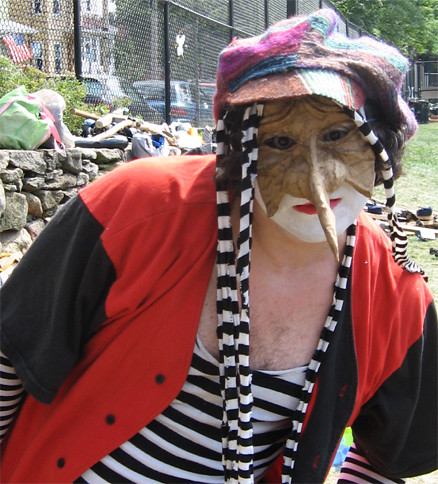
Eventually, I settled upon the character of Zanni, one of the very oldest of commedia characters-- whose name, a diminitive of "Giovanni", has become the generic label for all the servant characters as well as the origin of the word "zany". Zanni is a porter, and so, because of the relative size of the actors, Zanni could carry any of the other characters on his back. I described him as Arlecchino's uncle, and one of the girls, very intuitively corrected me with "No, Zanni is like Arlecchino's great-great-grandfather!"
I came up with the scenario during the final week of rehearsals, borrowing two elements from the scenario Michael McAfee dreamed up for the i Sebastiani anti-Masque we performed for Vision of the Twelve Goddesses: that Pantalone is staging a theatrical event in the hope of raking in the ducats and that Il Capitano wants to be the star of the show.
In this scenario, however, Pantalone is the producer for the circus. We have a series of lazzi in which Zanni is misidentified as a steed (by Pantalone as a horse, Il Dottore as an elephant, and Il Capitano as a giraffe, and Arlecchino as whatever anyone else says) and repeatedly ridden around, as Il Dottore lobbies for a more gourmet menu at the concession stand (more work for Franchescina, and more confusion for Arlecchino,) Il Dottore misdiagnosing Il Capitano as a corpse, Capitano swearing vengeance on Il Dottore and Pantalone, Franchescina standing up to Il Capitano, and Arlecchino and Franchescina riding off stage on Zanni's back.
One rather funny mistake: on the last performance, the performers playing Franchescina and Arlecchino, instead of climbing onto my back at the end, somehow both leapfrogged right over me, but there are no mistakes: incorporate it into the next show!
Now: to dream up a scenario for next year.
See more photographs on my flickr account.
Posted by
Ian Thal
at
11:23 AM
4
comments
![]()
![]()
Labels: arlecchino, Capitano, commedia dell'arte, Dottore, Franchescina, Mark Jaster, Open Air Circus, pantalone, Sabrina Mandell, Smeraldina, Somerville Massachusetts, teaching, theatre, youth circus, zanni
Monday, August 6, 2007
Almost a Year of Kathak
Some of my readers are aware that for much of the past year, I have been studying kathak from Gretchen Hayden of the Chhandika Chhandam Institute of Kathak Dance. Kathak, for those of you who are unfamiliar, is a dance-theatre form (I have read that "dance" is a misnomer resulting from British colonists attempting to translate what they observed into their own categories) that while having ancient roots, began to take its modern form in Northern India and modern day Pakistan, under the influence of the Mughal courts where it took on influences of Persian dance.
Kathak is a classical performance art form in that it conforms to the theories and guidelines of the Natya Shastra written by the sage, Bharata Muni. There appears to be some minor disagreement amongst scholars of whether there are six, seven, or eight schools of dance-theatre that are of classical stature, and since I am not a scholar in the field and have no opinion on the matter.
I had first become aware of Indian dance in general in 2003 when I was present for an informal presentation by foreign student at Open Floor, a sort of workshop and show and tell for movement artists. I immediately saw the formalist storytelling elements, and saw a commonality between Indian dance traditions and European mime (specifically the corporeal mime I had been studying from James Van Looy) as well as the impulse to synthesize movement with poetry-- something I first saw articulated by William J. Barnum. (Cosmic Spelunker Theatre began as a trio between Barnum, Van Looy, and myself.)
I began to seek out every Indian dance concert I saw announced, first becoming aware of Bharatanatyam which developed primarily in Tamil Nadu, before seeing a student show by Chhandika and being exposed to Kathak. I attended a few shows as well as a few open workshops until last fall, when one of the more advanced students noted, "you've been attending our concerts for years and you are a performer, why don't you come study with us?" So I did.
A kathak performance involves a recitation of either a poem or of bols (a composition of syllables used as notation by Indian drummers) while engaged in complex percussive footwork while the upper body mimes the narrative. I was obviously first attracted by the mimetic and poetic elements, but it is the rhythmic footwork that forms the foundation of this dance, and percussion has never been my strong point-- so it has been a steep learning curve for me-- but I have been learning.
Posted by
Ian Thal
at
3:47 PM
2
comments
![]()
![]()
Labels: chhandika, corporeal mime, dance, Gretchen Hayden, James Van Looy, kathak, mime, William J. Barnum
Sunday, August 5, 2007
Open Air Circus, August 10-12 in Somerville, MA

Come see my mime and commedia dell'arte students perfom with the Open Air Circus, Somerville's own youth circus, this coming weekend at Nunziato Field in Union Square.
This is my third year teaching mime and my first teaching commedia to the wonderfully funny bunch of kids at Open Air.
Show times are:
Friday, August 10 @ 7pm
Saturday, August 11 @ 2pm & 7pm
Sunday, August 12 @ 2pm
Tickets are $3
Posted by
Ian Thal
at
8:30 PM
5
comments
![]()
![]()
Labels: commedia dell'arte, mime, Open Air Circus, performance, teaching, youth circus
Saturday, August 4, 2007
Midsummer Night's Dream on the Common
Last week, I twice attended the Commonwealth Shakespeare Company's free production of A Midsummer Night's Dream, which, provided you can get good seating, was a wonderful show (I went Friday last with a friend who has children and a good half of the stage was obscured by foliage-- while I had a great view, including the other half of the stage, on Sunday when I went alone.) This year's Shakespeare on the Common production was marred by budget cuts that resulted in a scaled back run (one week instead of the typical three weeks) even though the President and CEO of the Citi Performing Arts Center (CPAC), Josiah Spaulding Jr. received a $1.265 million bonus. Bill Marx does a terrific job of following the money trail on his blog.
However, since I am an artist and know nothing of money (said by Charlie Chaplin in contract negotiations with First National films just before stating "I only know that I want one million dollars") let me sketch out what I thought of the production:
While spectacle is a necessity when presenting a play in a big open space like the Boston Common, the scaled back budget did not harm the production values of the show. The minimalist stage merely meant that the spectacle had to come from the actors' performances rather than fancy set designs.
Those familiar with the play, are aware of the three main plot lines each of which involve their own troupe of players. What distinguished these three groups: The Athenians, the Mechanicals, and the Fairies from one another was not just the costuming, but styles of physical acting.
The Athenian lovers -- the most one dimensional of characters in the written script -- are exactly the stock comic lovers of European renaissance comedy (they would be equally at home in the Italian commedia dell'arte) but what made them so effective in this production was that they took the character's adolescent petulance into realms of slapstick: Hermia being flung off the stage, a rageful Helena throwing herself at Hermia and being caught by Lysander and Demetrius, Helena and Hermia climbing onto the shoulders of Lysander and Demetrius as if preparing for a joust.
The Mechanicals were a troupe of capable physical comedians of another order entirely: skilled clowns (I certainly detected a great deal of physical technique in all of them) they certainly gave the appearance of being a cohesive troupe-- indeed just the sort of physical comedy troupe in which I would like to take part some day. Fred Sullivan, Jr. was a great Nick Bottom, and Leslie Harrell Dillen's manic portrayal of Tom Snout (the mechanical who plays "Wall" in the play within a play sequence) caused me to briefly forget Bill Irwin's very different Snout in Michael Hoffman's 1999 film adaptation.
The Fairies were choreographed by my ballet teacher, Anna Myer (whom I have mentioned before), and while they often exhibited the ethereal nature one associates with ballet, she also imbued them with a lusty Dionysian quality-- and while I have read in the blogosphere many comparisons to Cirque du Soleil (whom I happen to adore), I found the effect to be that of a court masque performed by satyrs. They were appropriately otherworldly and without Athenian propriety. (Anna told me after class this past Tuesday, that while her duties were mostly to choreograph the Fairies, she also choreographed the final dance with the Mechanicals, and was consulted on some of the other scenes as well.)
(I'd like to add that J Hagenbuckle's music and sound design also added much to the show-- mixing elements of sound collage, goth-rock, electronica, and a number of genres I'm too out of touch with contemporary pop to identify.)
Posted by
Ian Thal
at
8:09 AM
0
comments
![]()
![]()
Labels: A Midsummer Night's Dream, acting, anna myer, Bill Irwin, Charlie Chaplin, clowning, dance, Fred Sullivan Jr, J Hagenbuckle, Leslie Harrell Dillen, Shakespeare, theatre
Wednesday, August 1, 2007
Thither Macbeth has gone to November
I arrived ten minutes late to rehearsal this evening to find the cast gathered in a circle. As I took my seat, I realized I had missed a monumentous announcement, so it was explained to me: Due to work commitments, we lost our Banquo, we still had not found our Donalbain, and since it was clear we needed to postpone the performances, we lost our Macbeth as well, since the actor was in from Los Angeles and was only in Massachusetts for the summer.
So we are recasting those roles and tentatively moving our our production to early to mid November depending on the availability of the space.
I still do not believe in the curse.
The remaining cast was invited to audition for the now open roles but I decided that I was sufficiently pleased with the ones I am already playing as they were sufficiently against the type of which I have been previously cast.
In the interim, it seems that the Lallygagging Players will be changing their name.
Posted by
Ian Thal
at
8:20 PM
2
comments
![]()
![]()
Labels: acting, Lallygagging Players, Macbeth, Shakespeare, theatre


